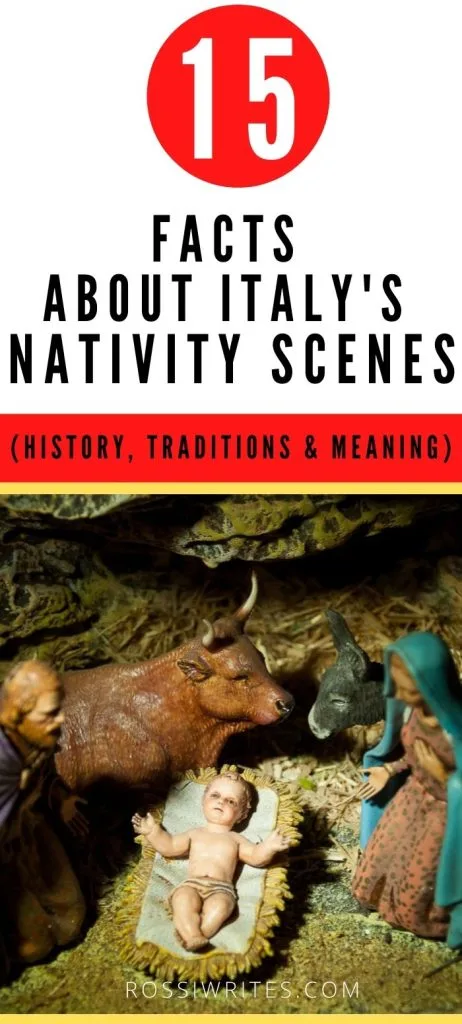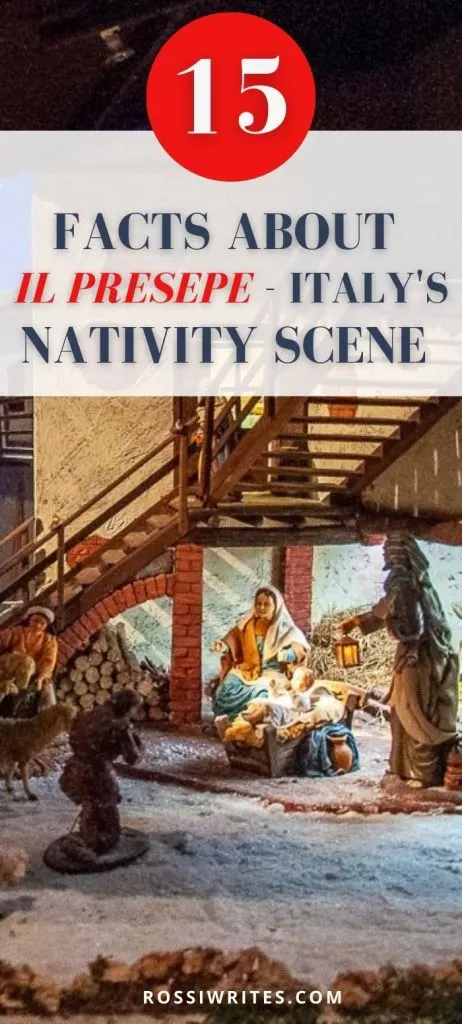Here are 15 curious and interesting facts about Italy’s traditional Nativity scenes.
Known as presepe or presepio (pl. presepi) in Italian, they are a central part of the celebration of Christmas in Italy.
A Nativity scene (also called a manger scene, a crèche or a crib in English) is a representation of the Holy Family in the stables in Bethlehem. While a lavishly decorated Christmas tree takes centre stage in billions of homes around the world at Christmas, in Italy the main focus is on the presepe. Beyond a simple Christmas decoration designed to adorn a space and to please the eyes, the Italian Nativity scene has a deeper meaning for it visually retells the episodes of the Nativity Story. It thus keeps firmly the focus of Christmas on the main event – the Birth of Christ.
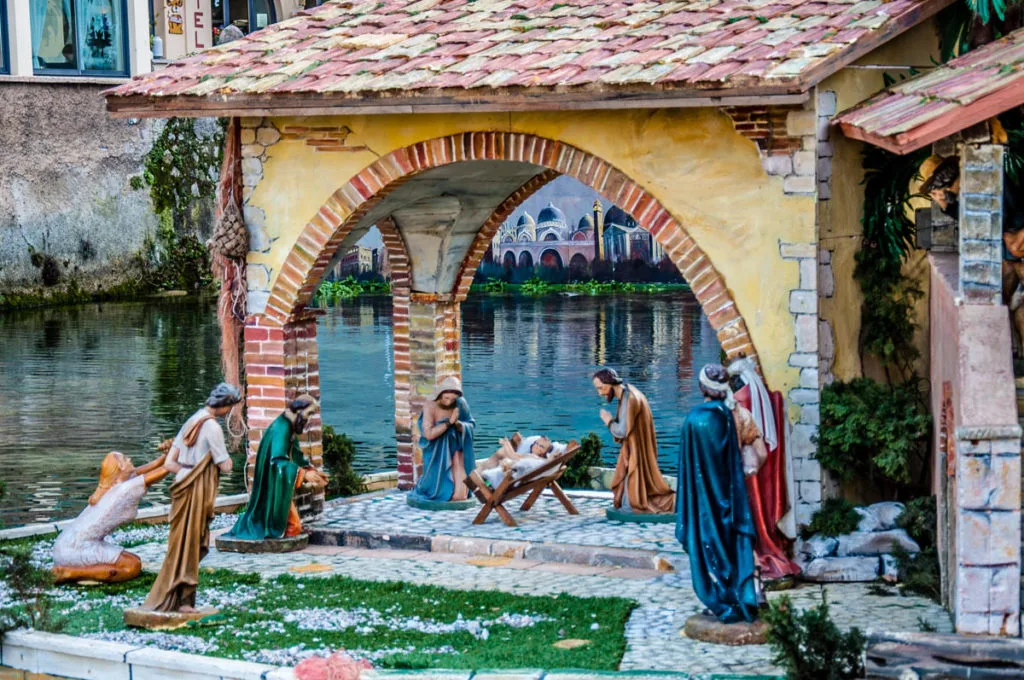
Come December and Nativity scenes are carefully set up all over Italy. From private homes to chapels, churches, and squares, you will see presepi everywhere here.
They can be small with tiny figurines of the main Nativity characters – the Infant Jesus, the Virgin Mary, St. Joseph, the Three Wise Kings, and the ox and the donkey. Or they can be human-size and include numerous elements.
They can consist of just the stables or be incredibly elaborate. Sometimes, the whole town of Bethlehem is recreated in minute detail – from the marketplace with all sorts of stalls and workshops to many different animals, houses, and people going on about their daily lives.
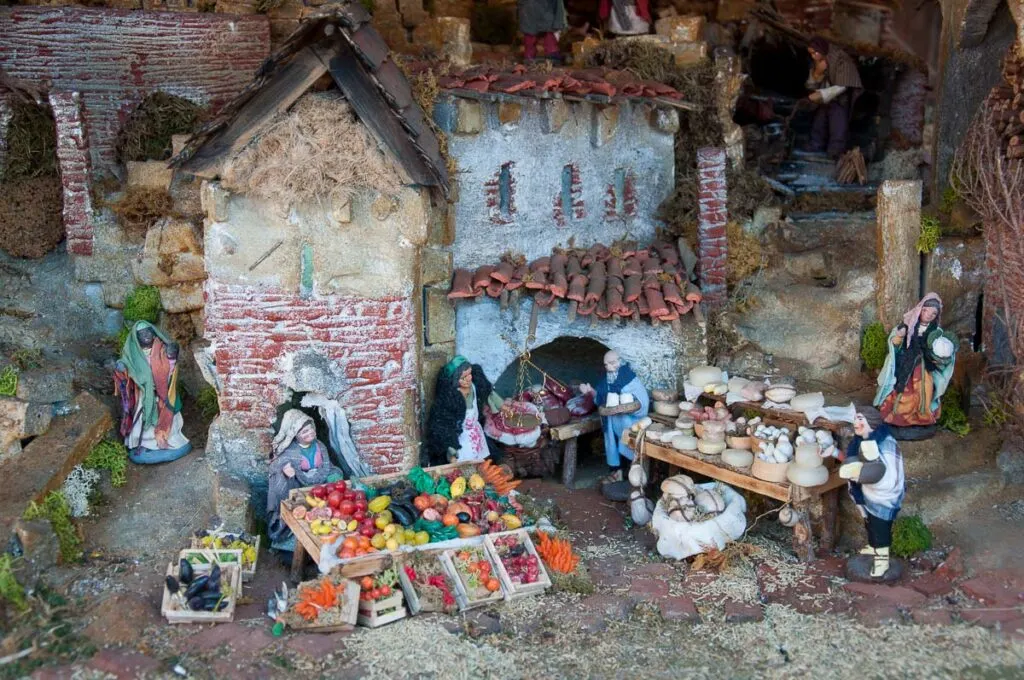
During the six years that I spent living in Italy, Christmas or Natale as they call it in Italian was always my favourite holiday. With the Christmas festivities lasting a whole month and with the focus on celebrating surrounded by family, it was a wonderful season – peaceful, unhurried, and bringing you closer to the people you love.
We would spend time browsing Christmas markets, visiting small towns and large cities to admire their Christmas illuminations, and treating ourselves to large slices of panettone accompanied by cups of exquisite Italian hot chocolate. Among it all, the presepi were always my most favourite thing about spending Christmas in Italy. While setting up a Nativity scene is not part of my Christmas traditions, I quickly embraced this Italian custom.
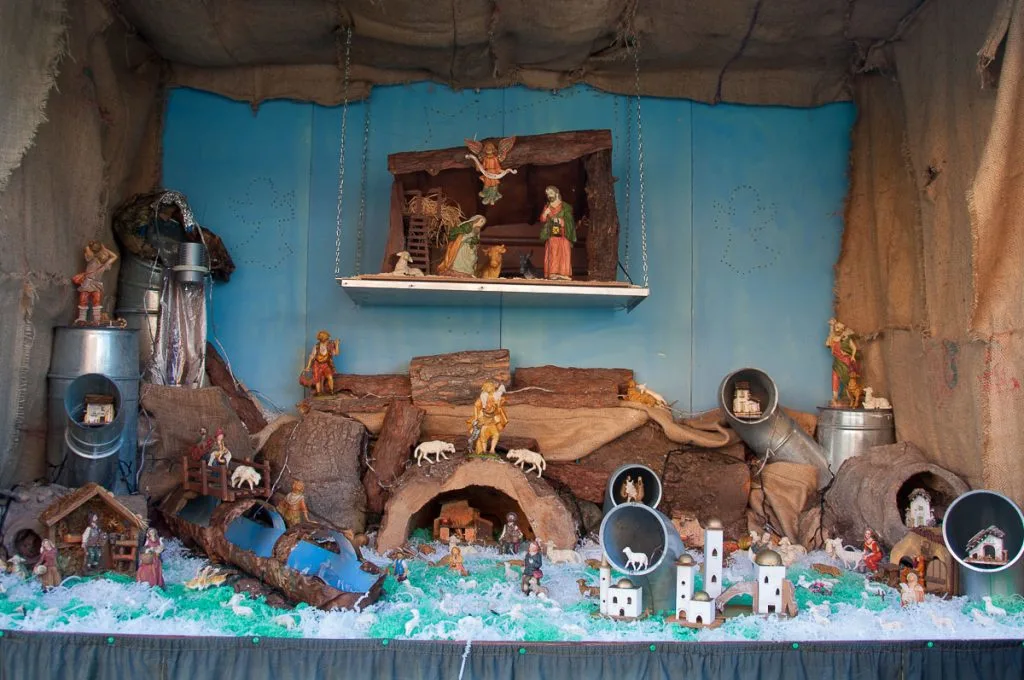
Each Christmas season, we would visit the local churches to see their Nativity scenes. We would hike to small villages in the Italian hills and mountains where hundreds of artisan presepi would be placed along the cobbled streets and in the roots of centuries-old trees. We would also head to Verona to see the large exhibition of presepi that takes place every winter in the city’s 2,000 years old Roman Arena. And once, we spent a whole day queuing to experience a magnificent Living Nativity scene which is held only every two years in a series of caves high above the Venetian plains.
Above all, each Christmas season we would set up our own Nativity scene at home. It’s very small, portable, and to be honest, we never got into the Italian habit of buying new pieces for it every year. Yet, taking it out at the start of December alongside the medley of Christmas decorations we had accumulated throughout the years – each shiny bauble and each handmade ornament with their own story to tell – made us feel a bit more like we belonged in Italy where finding your feet and feeling accepted by the locals is not always easy at all. Here we were – a small family made up of my husband who is English, me who is Bulgarian, and our child – a happy mixture of both with a dash of Italian influences.
Our small Italian presepe was one of the things we carefully packed and took with us when the time came to return to England after six years in Italy. And the whole Italian culture around Nativity scenes was one of the things I missed the most during our first Christmas in England after Italy.

So, with the Christmas season around the corner, I decided to write this blog post to share with you 15 curious facts about Italy’s Nativity scenes. From the history and traditions of the Italian presepi to their varieties and meaning, I have organised in easy and fun chunks of text everything that I have learned throughout the years about this lovely Italian custom. To illustrate this blog post, I have used photos that I have taken of presepi over many holiday seasons all over Italy.
I hope that you will find this blog post interesting and intriguing. I hope that it will provide you with lots of curious information to share with those you love over a festive lunch, drink or meet-up during this Christmas season. Above all, I hope that this blog post will inspire you to get your own Nativity scene or even better, to experience Christmas in Italy as soon as this is possible.
Have a look!
Presepe or 15 Facts about Italy’s Nativity Scenes – History, Traditions, and Meaning
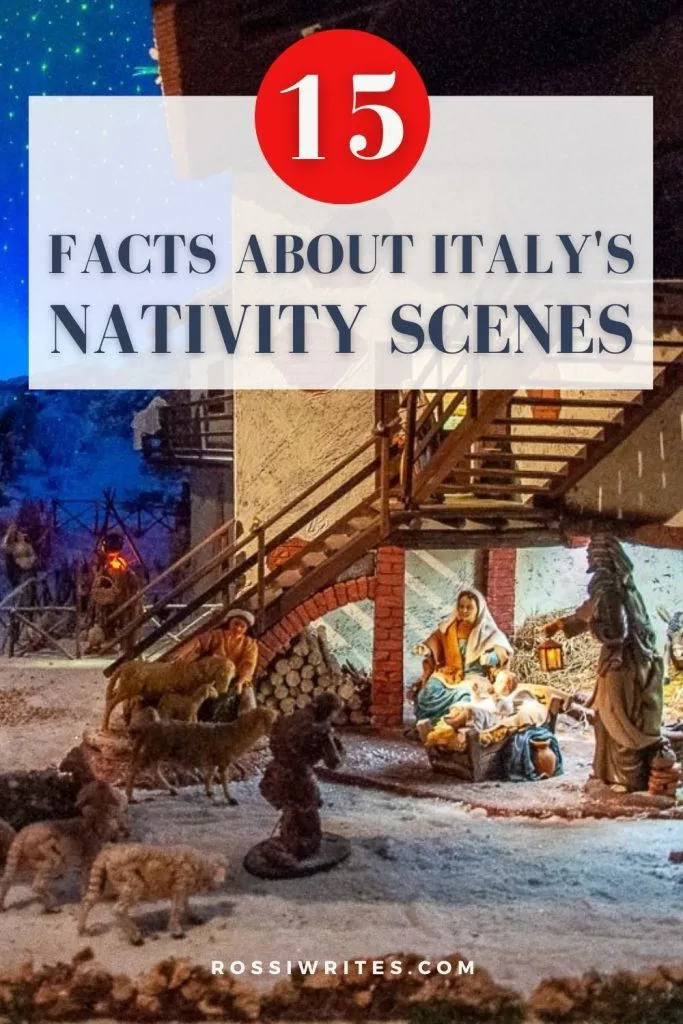
1. The Italian Words for Nativity Scene are Presepe and Presepio
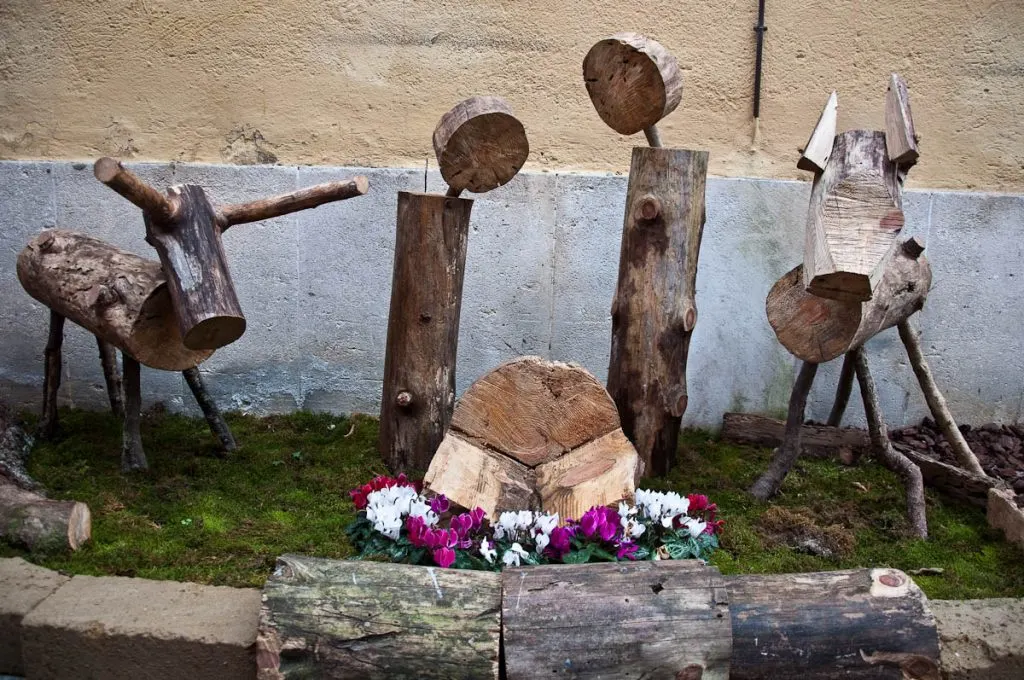
The Italian words for Nativity scene – presepe and presepio (pl. presepi) – come respectively from the Latin terms praesaepe (meaning enclosure, pen or hut, dwelling) and praesepium (meaning crib or manger). The root of the Latin terms is the verb saepire – to surround, to enclose, to wrap. According to linguists, praesaepe is the older form. However, it was the word presepio that first entered the Italian language as praesepium (from which it originates) is the term used in the text of the Vulgate – the 4th-century Latin translation of the Bible.
The description of the Nativity Story in the Gospel of Luke (2: 6-16) mentions the word praesepium three times. In English, this is translated as ‘manger’. Have a look here at the respective texts in both English and Latin side by side.
In the centuries that followed, presepe also entered the Italian language directly from Ancient Latin sources. For example, the writings of the Roman poet Virgil who used praesaepe in the 1st century BC. Up to a few centuries ago, presepe was considered to be a more cultured and refined term in Italian and as such it was used much more rarely than presepio. Plus, initially, presepe meant just the stables and presepio – the actual manger. However, this semantic difference was soon obliterated.
Nowadays, both presepe and presepio in Italian refer both to the actual manger in which Jesus was laid at birth and also the cave (or stables) in which he was born. In addition, the Italian Encyclopedia of Science, Letters, and Arts (known as Treccani after the name of its developer) also defines presepe as any representation of the episodes of the Nativity Story (like the birth of Christ and the Adoration of the Magi) that is placed in private homes, churches, and public places during the Christmas holidays and which contains figurines made of various materials and a more or less realistically reconstructed environment (which sometimes can be anachronistic or in other words, not corresponding to the style of the era in which said Biblical events are purported to have happened).
If you want to delve deeper into the linguistic origins of the Italian words presepe and presepio, I recommend this detailed article in Italian. Otherwise, in this blog post, I use predominantly the term presepe as this is what I got used to using when living in Italy.
2. Presepi Are the Focus of the Christmas Decorations in Italy
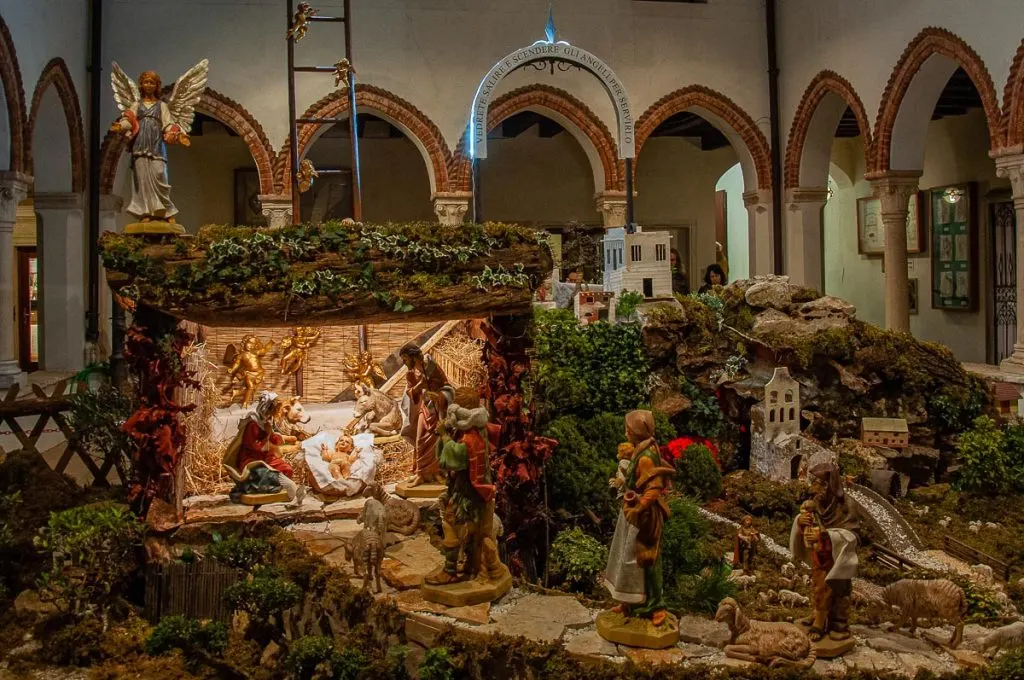
Christmas trees – beautifully decorated with baubles, tinsel, and the Star of Bethlehem or an angel as a tree topper – nowadays are the most central Christmas decoration in homes and public spaces all around the world. Yet, they remain very much a newcomer to Christmas in Italy.
It is said that the first Christmas tree was erected in Italy at the end of the 19th century at the idea of Queen Margherita of Savoy. However, during the first decades of the 20th century, Christmas trees were very much considered a foreign fashion in Italy and frowned upon.
A Christmas tree was erected for the first time in St. Peter’s Square in the Vatican only in 1982. This is when the then-serving Pope John Paul II chose to introduce this Northern European symbol of Christmas to the festivities taking place in Rome. The first tree came from Italy, but since then a different European country donates a huge tree every year.
In the meantime, the presepe has been at the centre of the Christmas celebration in Italy for many hundreds of years. It is much more than a simple decoration that is appreciated for its beauty and whimsicality. It is, above all, a visual representation of the episodes of the Nativity Story. As such, it helps believers to feel closer to its events and, in a way, to become part of them by setting up the presepe at home or by setting time aside to see the presepi arranged in local churches, displays, and exhibitions.
Traditionally, Italian families get together on the 8th of December each year to set their Nativity scene. This is also the day on which the long Christmas season in Italy starts, too. 8th December is a public holiday in Italy. It marks the Feast of the Immaculate Conception of the Virgin Mary. In fact, some Italians start setting up their presepe as early as 29th November which also marks the start of the Immaculate Conception novena – the period of nine days of prayer preceding the actual Feast.
A presepe is very much a work in progress. The Italian family may arrange the Nativity set on the 8th December, however (and as we will see in point 8 below), the different events of the Nativity Story require that different figurines are added to it at particular moments in time. And then (as we will see in point 11 below), many Italian families keep adding pieces and accessories to their presepe all life long.
Most importantly, while the Italian Christmas season concludes with Epiphany on 6th January, the presepe may stay out as late as the end of January or even the start of February. It is a wonderful way to still feel immersed in the magic of Christmas even long after the conclusion of the main festivities.
3. The First Nativity Scene in Italy Was Set-Up in the 5th Century AD
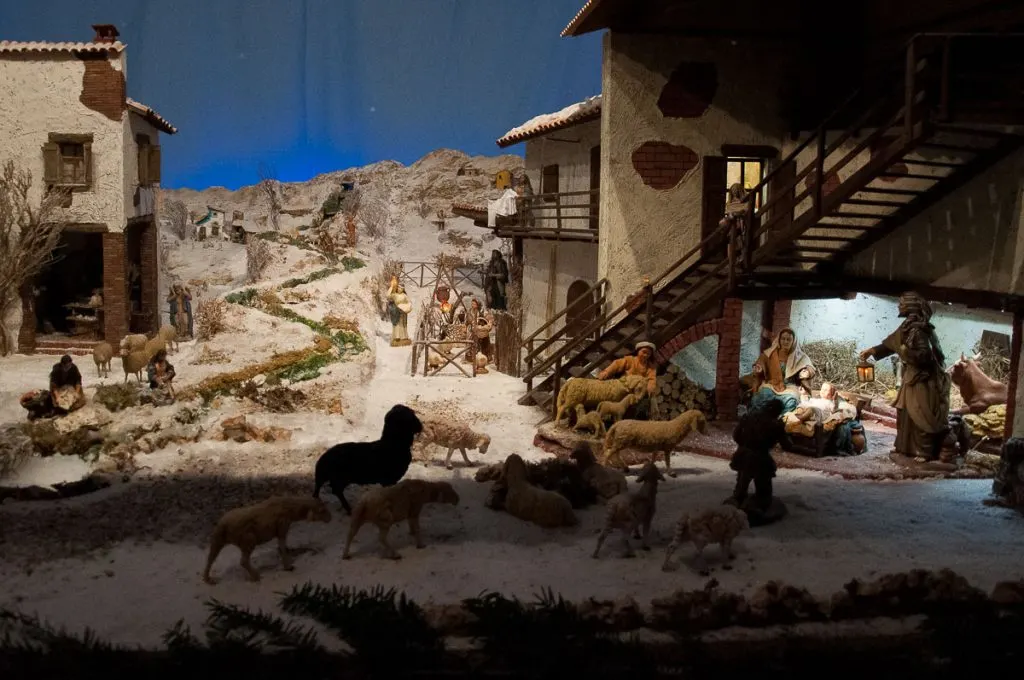
The Italian tradition of setting up a Nativity scene for Christmas is almost 1,600 years old.
Back in 432 AD, a special chapel housing the Cave of the Nativity (in Italian, Grotta della Nativita’) was built inside the Basilica of Santa Maria Maggiore in Rome. Under the guidance of Pope Sixtus III, it reproduced the birthplace of Jesus. The Pope’s wish was for a place in Rome where he could pray as if he were in Bethlehem.
This is why the Basilica of Santa Maria Maggiore is also known as Sancta Maria ad Praesepe (in English, St. Mary at the Manger). This ancient Christian church is the largest of the 26 churches dedicated to the Virgin Mary in Rome and it’s one of the city’s four major basilicas. It is also the only one of them to have preserved its paleo-Christian structures.
Interestingly enough, the Basilica of Santa Maria Maggiore in Rome is connected to the Nativity Story in more ways than one as we will see in points 4 and 5 below.
4. The Actual Crib of Baby Jesus is in a Roman Basilica in Italy
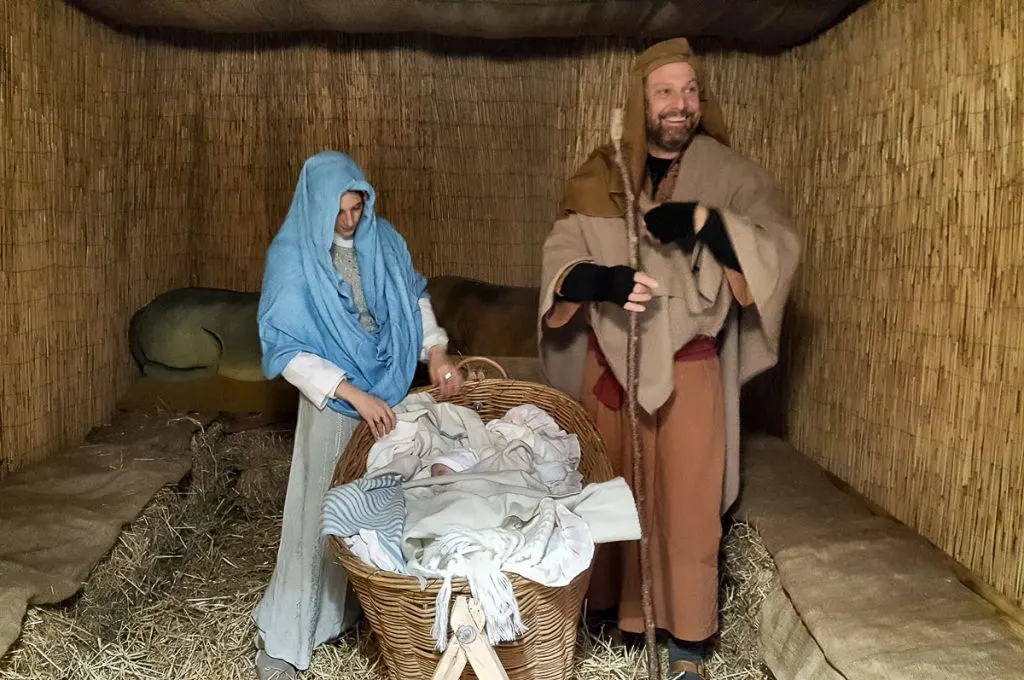
The Biblical manger (in Latin, cunambulum) in which the Infant Jesus was placed after His birth is known as the Holy Crib or the Sacred Crib. It is hypothesised that in the mid-7th century AD, the relic of the Holy Crib was given to Pope Theodore I by the Patriarch of Jerusalem, St. Sophronius. It was brought to Rome and placed in the Basilica of Santa Maria Maggiore as it was the place where two centuries earlier Pope Sixtus III had built the Cave of the Nativity.
The relic consists of five boards. Allegedly, it’s been confirmed that four of these are compatible with sycamore or maple trees that grew 2,000 years ago in Palestine. It is suggested that the fifth board could have been part of an ancient painting of the Nativity Story that was lost during the Sack of Rome in 1527.
Nowadays, the relic is still in the Basilica of Santa Maria Maggiore where it is kept in the Crypt of the Nativity (also known as the Bethlehem Crypt). This was created in the 16th century when the original Cave of the Nativity was moved under the basilica’s high altar. The Holy Crib is placed in a precious crystal urn trimmed in silver and adorned with gold figurines. The urn was made in the 18th century by the famous architect, goldsmith, and designer Luigi Valadier. You can see two images of it here and here. By clicking on this link, you can also see the wooden boards of the Holy Crib inside the open urn.
The urn was opened in 2019 when a thumb-sized piece of the relic was extracted to be returned to Bethlehem. There, it is kept in the Franciscan Church of St. Catherine next door to the Basilica of the Nativity.
5. The Oldest Nativity Set in Italy Dates Back to the 13th Century
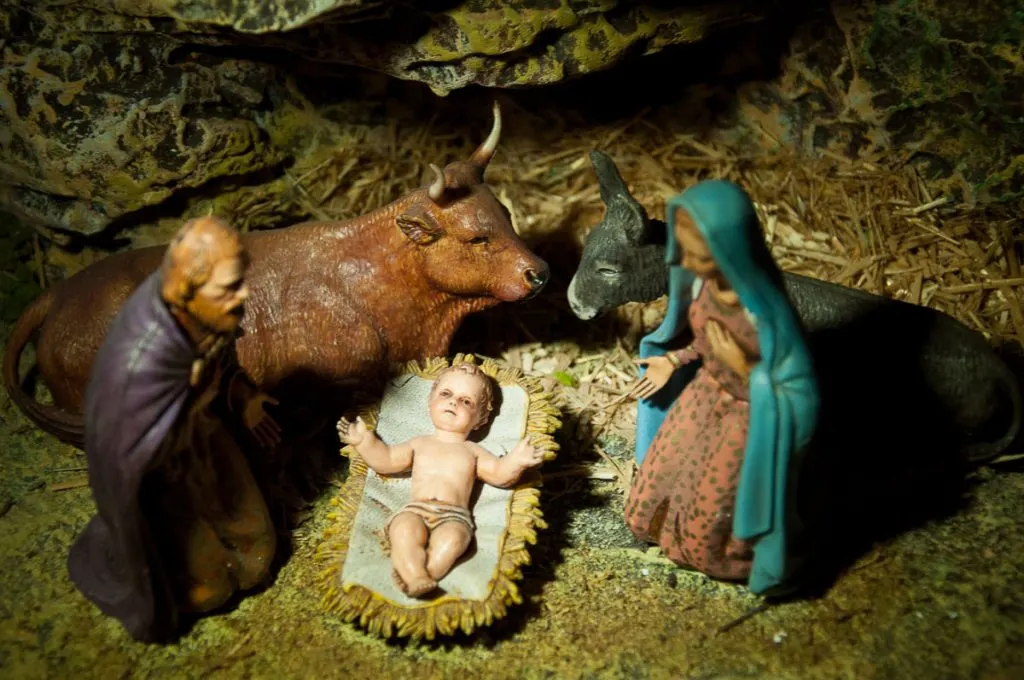
Italy’s oldest Nativity set to survive to this day was carved in marble back in 1291. It was commissioned in 1288 by Pope Nicholas IV. Some sources state that the inspiration behind it was the Cave of the Nativity in the Basilica of Santa Maria Maggiore in Rome. Others insist that it was made in honour of the first living Nativity scene that had been held about seventy years earlier by St. Francis of Assisi in a cave in the village of Greccio (for more on this, see point 13 below).
Either way, the author of this Nativity set is Arnolfo di Cambio – a renowned Gothic sculptor and architect from Tuscany. He worked in Florence and Rome, provided the first design for the Florence Cathedral, and was part of the workshop of another renowned sculptor – Nicola Pisano.
Arnolfo di Cambio’s Nativity set consists of eight figures (you can see an image of it here). The Madonna with Child is at the centre. Around her, stand St. Joseph and the Three Wise Men. The donkey and the ox observe the peaceful scene from the side. For many centuries this priceless work of art was kept in the Crypt of the Nativity of the Basilica of Santa Maria Maggiore in Rome. Nowadays, it is on display in the basilica’s museum.
6. Exhibitions of Nativity Scenes Are Held All Over Italy During the Christmas Season
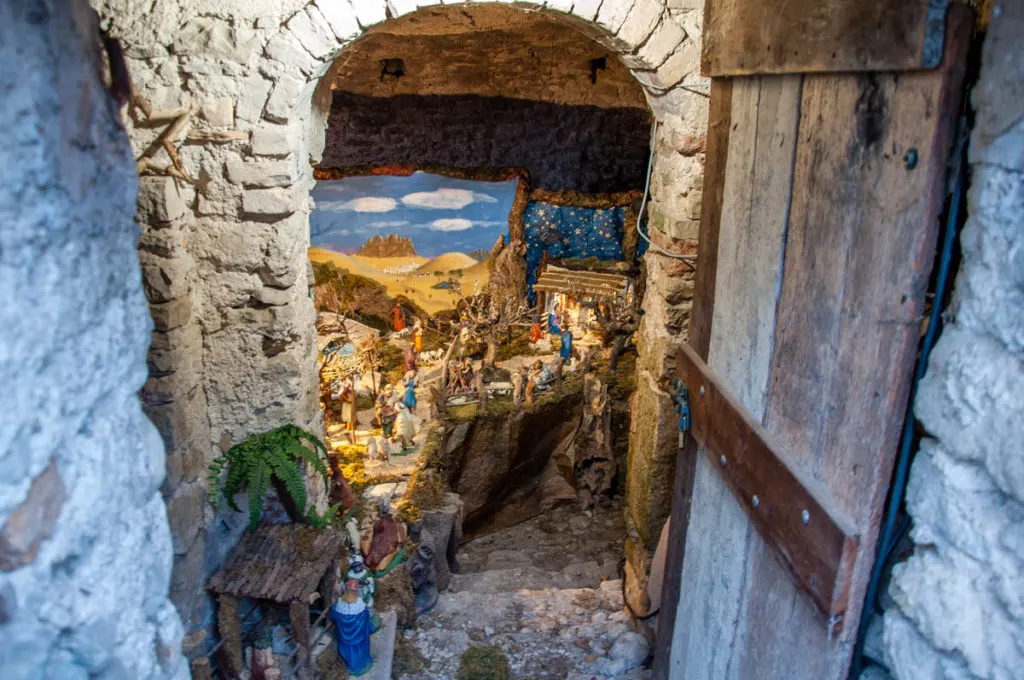
One of the loveliest things to do during the Christmas season in Italy is to visit an exhibition of handmade Nativity scenes. Held in churches, community halls, and in some cases outdoors, they often consist of dozens if not hundreds of artisan Nativity sets in any possible size and style.
The International Exhibition of Nativity Scenes in Verona is particularly famous. It showcases over 400 artisan cribs made by craftsmen and Catholic communities from all around the world. The Nativity sets are arranged under the internal arches of Arena di Verona – a Roman amphitheatre with a story that spans 2,000 years. The exhibition opens at the end of November and lasts until the end of January. It’s been held for over three decades.
My favourite exhibitions of Nativity sets in Italy were the ones held in small medieval villages surrounded by stunning nature. The ten-centuries-old village of Campo di Brenzone, for example, hosts a large exhibition of cribs every December and January. Only a handful of people still live there and the village can only be reached on foot by hiking on stone-paved mule tracks that lead high up in the hills above Lake Garda. Walking from house to house to admire the dozens of Nativity scenes set in abandoned courtyards and under lush olive trees is an experience like no other.
You can find more information about other must-see Nativity scene displays and exhibitions in the entry dedicated to them in this Christmas Guide for Italy.
7. There are Also Nativity Scenes Museums in Italy

Even if you don’t visit Italy during the Christmas season, you can still get close to the country’s traditional Nativity scenes by visiting a museum dedicated to their history and craft.
For example, all year round you can visit the Museo Nazionale di San Martino in Naples to admire the staggering Cuciniello Nativity. This large and complex presepe includes the figurines of 173 people, 42 angels, and 80 animals (including two monkeys!). 450 miniature objects complete the scene. This article gives a lovely overview of the Cuciniello Nativity and provides many photos of it.
Another must-see destination is the Museo del Presepio in the small town of Dalmine in the Province of Bergamo in Lombardy, Northern Italy. It has 500 Nativity scenes in its collection.
In Rome you will find the Museo del Presepio ‘A. Stefanucci’. Unfortunately, this museum is currently closed but do keep an eye on its website for future developments. In the meantime and if your interest in the Italian Nativity scenes is particularly deep, you can follow the activities of the Italian association Amici del Presepio. It shares many Nativity-making tutorials, publicises upcoming exhibitions of Nativity scenes, and even publishes a specialised magazine.
8. The Italian Presepe Follows the Development of the Nativity Story
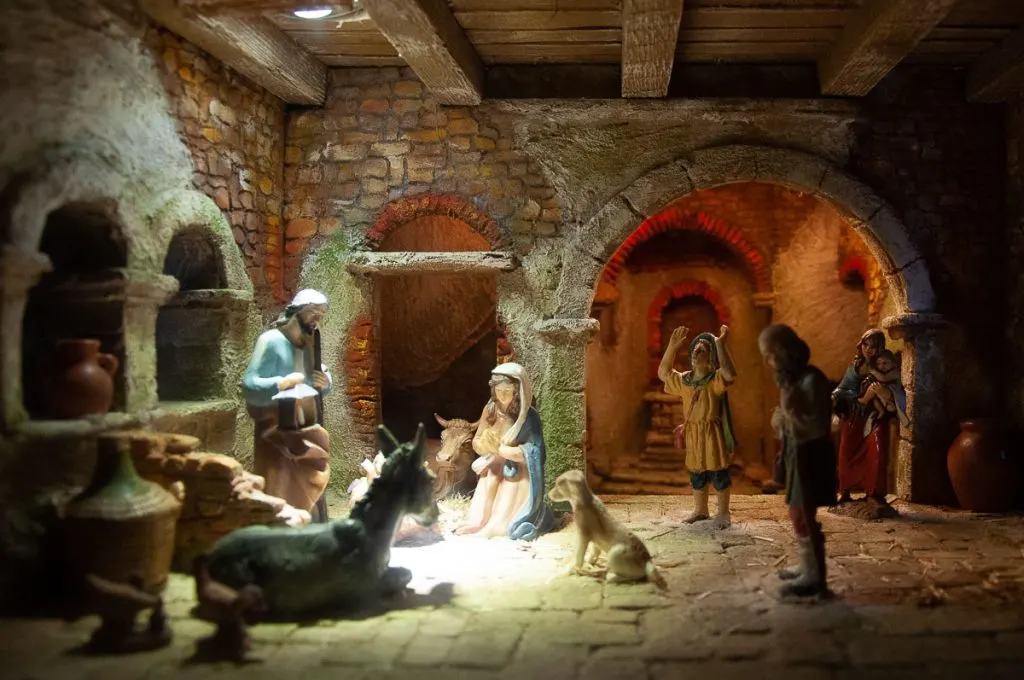
As covered in point 2 above, traditionally, the Nativity scene gets arranged in Italian churches, squares, and homes on 8th of December. Yet, the Italian presepe is not a static piece of Christmas decoration. It follows strictly the development of the Nativity Story and its many episodes.
Most importantly, the figurine of the Infant Jesus is only added to the manger at midnight on Christmas Eve. Before then, in some Italian families, kids receive a handful of hay for each good deed they do during the month of December. They use the hay to layer the manger and make it more comfortable for the arrival of Baby Jesus. This creates a connection between the kids and Bambino Gesu’. It inspires an emotional response to the events of Christmas.
In addition, when at midnight on Christmas Eve, the figurine of Baby Jesus is added to the manger of the Nativity Scenes carefully set in the many churches of Italy, the church congregation receives a powerful visual representation of the culmination of the Nativity Story. People become involved participants in it, they see it happening in front of their eyes rather than simply hearing about it from the priest.
With the arrival of the Three Wise Kings on Epiphany – 6th January – their figurines are also added to the presepe. Thus, the Italian Nativity Scene is an ever-evolving representation rather than an unchanging piece of decor. It’s something to continuously return to during the festive season, to take care of, to connect with, and to spend contemplative moments around it together with your family and loved ones. It appeals to the senses and it creates a powerful emotional link to the root cause of the festivities – the Birth of Christ.
9. Nativity Scenes in Italy Are Made of Many Different Materials
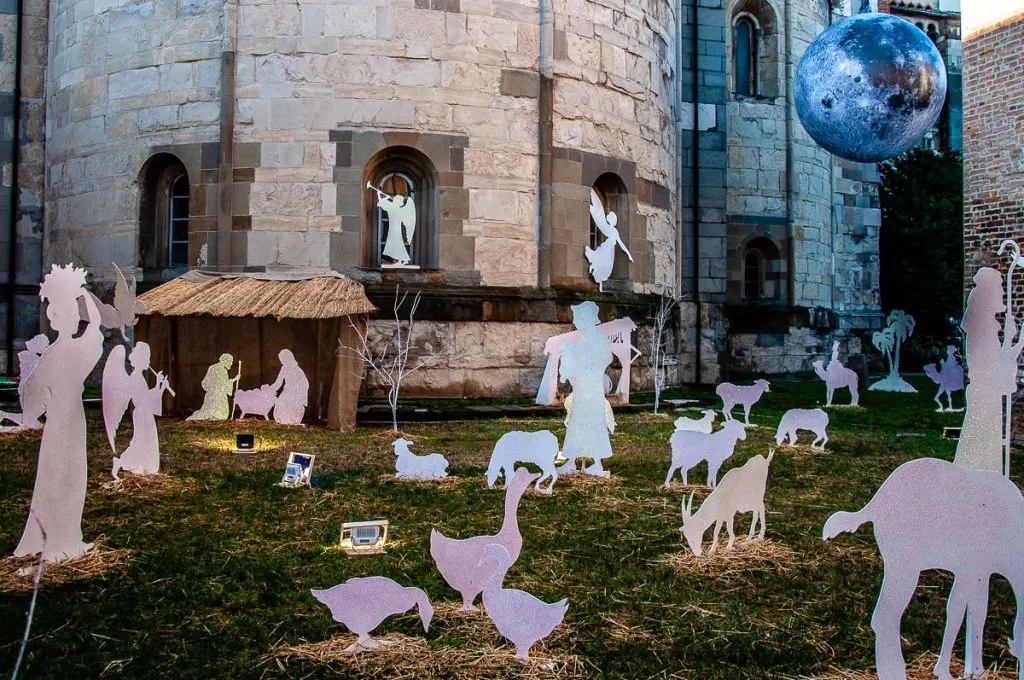
As we saw under point 5 above, the oldest Nativity set preserved in Italy to this day is carved out of marble. Still, most Nativity scenes made in Italy since then have been produced of much lighter and cheaper materials. Wood, paper-mache, terracotta, wire, cardboard, and resin are some of the most popular mediums. They are lightweight, can be shaped in many different ways, and render themselves well to the variety of figures and accessories needed for an Italian presepe.
In addition, the stables, the houses, the market stalls, the workshops, the streets, and the many other different details and pieces that one may need to build a presepe in Italy, are often made of natural materials – from cardboard, wood bark, and pebbles to straw and moss.
The Nativity scene lends itself well to many different mediums – both natural and manmade. It’s open to creative interpretations that can be represented with the simplest of shapes and materials or with complicated forms and intricate decorations.
For example, for many years now the town of Jesolo in the Northern Italian region of Veneto erects a huge Nativity scene made out of sand. Between the Adriatic Sea and the Venetian Lagoon, Jesolo is famous for its long, wide beaches. Sand is not in short supply here! Every Christmas season, some of the world’s best sand sculptors arrive in Jesolo to chisel and carve an enormous presepe di sabbia. Its success has been such that in 2018 Jesolo’s Nativity scene was placed on St. Peter’s Square in the Vatican – the papal enclave inside Rome.
Nowadays, there are several towns in Italy that have embraced the sand Nativity scene. Among them are Rimini in Emilia-Romagna, Lignano Sabbiadoro in Friuli Venezia Giulia, Salerno in Campania, and Catanzaro in Calabria.
10. The Best Makers of Nativity Scenes in Italy Are in Naples
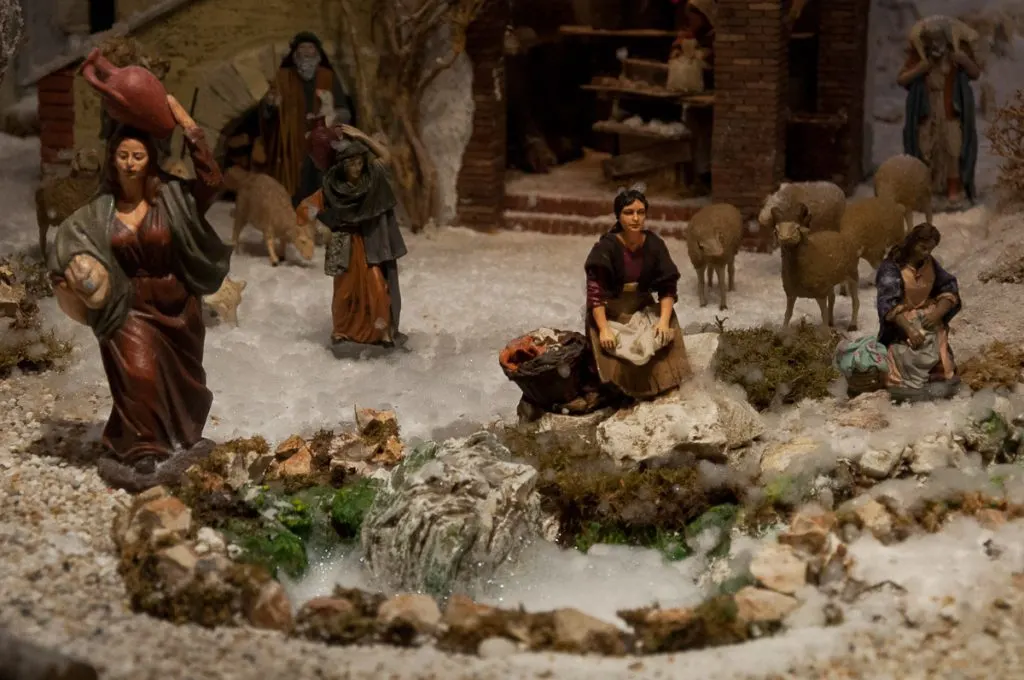
Traditionally, the best makers of Nativity scenes in Italy are in Naples. In this Southern Italian city, the making of presepi is an art form that has been mastered over many hundreds of years. The most curious thing about the Neapolitan Nativity Scenes is that they mix the sacred with the secular. In other words, a presepe made in Naples features many elements of daily life rather than representing exclusively the episodes of the Christmas Story. For example, expect to see a lively marketplace, the workshops of different artisans, women washing clothes in the nearby river or even a coop with chickens and stables with horses.
It’s all rather anachronistic, too. Italian cheeses and salami drape the market stalls. The clothes worn by the presepe‘s figurines are more 18th-century Italy than Roman Empire Bethlehem. The houses and settings are very much Italian, too. How did this all come to be?!
The link between Naples and Nativity Scenes is at least one thousand years old. For example, documents mention the existence in the city of a church dedicated to Santa Maria ad Praesepe (St. Mary at the Manger) as far back as 1025. In 1324, in Amalfi (near Naples) a Chapel of the Nativity was set up in the residence of a noble family. By the 15th century, the first figurarum sculptores (in English, sculptors of figures) were working in Naples, producing sacred representations for the local churches.
It was in the 16th century, however, that the custom of the Neapolitan Nativity scene as a mix of the Biblical and the secular began. Behind it stands San Gaetano da Thiene (known as St. Cajetan in English). He was the son of a noble family from the small town of Thiene near Vicenza in Northern Italy. San Gaetano spent his life in the service of God, he renounced all material goods and founded hospitals in Venice and Naples. In 1530, he made a presepe for the oratory of the Hospital of the Incurables in Naples. To bring the Biblical story closer to the sensibilities of his contemporaries, he made sure that the wooden figures in his Nativity scene wore clothes in the style popular in Naples at the time.
In the centuries that followed, the custom of creating presepi reflecting the local, contemporary culture of Naples was firmly established. This brought up major changes to the Nativity scene as a whole, especially in comparison with the cannons that had been established during the Middle Ages.
For example, instead of simply setting up the figurines against painted backgrounds, three-dimensional landscapes were introduced for the first time. All sorts of domestic and exotic animals were added to the Nativity scenes, too. The Biblical ox and donkey now had the company of sheep, chickens, cats, dogs, and even parrots and monkeys. Instead of fully carving out of wood the Nativity figurines, they were now made of wire to which either wooden or terracotta faces, hands, and feet were attached. Lavish clothes were sewn by hand to dress the figurines one by one.
During the 18th century and under the patronage of the Bourbon King Charles III, the Neapolitan Nativity scenes reached their highest point. This is when incredibly detailed presepi were created with the life-like figurines wearing silk outfits with beautiful accessories. The exuberant representation of daily life implied that a sacred event could happen anywhere and at any time.
Naples’ artisans keep the craft of the Nativity scene alive to these days. For a special experience in Italy, make sure that you head to Via San Gregorio Armeno when in Naples. This is where dozens of shops sell everything you may ever need to build the most spectacular Nativity scene with an authentic Neapolitan flair.
11. Building a Nativity Scene Can Be a Lifelong Exercise in Italy
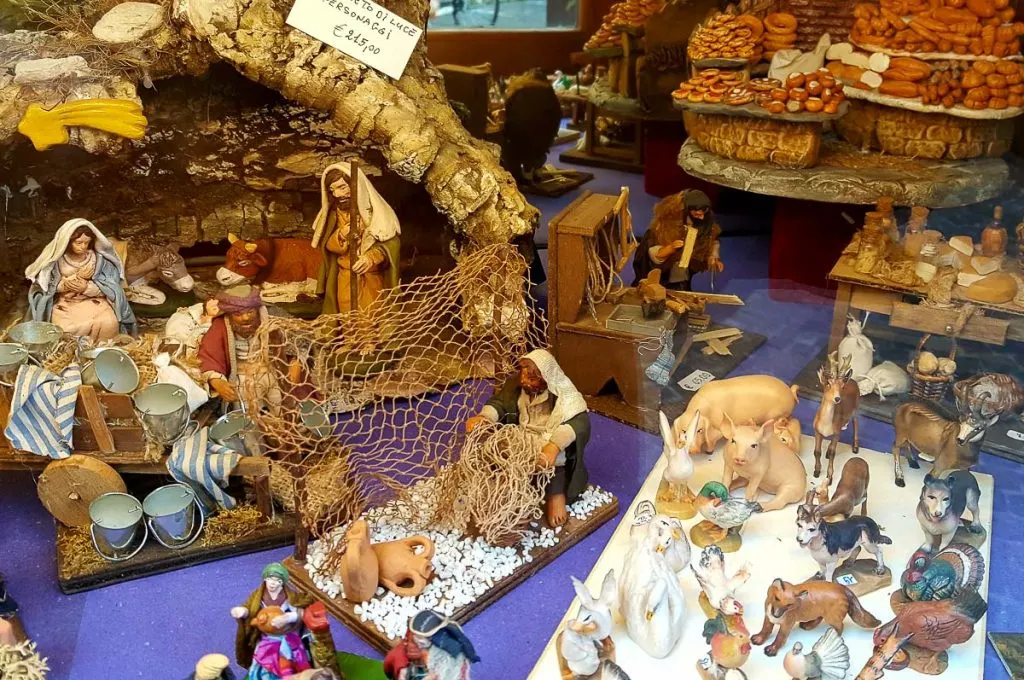
Having a beautiful Nativity scene set up at home in the run-up to Christmas is a question of personal pride and joy for the Italians. The presepe, however, is not a static decoration. Each year, a new piece is bought and added to the set-up. It could be a figurine for the cohort of the Three Wise Kings, another sheep for the shepherds’ flock or something entirely whimsical. Like a stall selling sausages to add to Bethlehem’s marketplace, a blacksmith’s workshop or an electrified water mill the wheel of which is turned by a babbling brook with real water.
The result is an ever-growing Nativity scene that Italian kids and their parents love to spend time setting up and rearranging each year at home.
Come November and Italian shops – from supermarkets and garden centres to small local toy shops and artisan studios – start selling a large variety of Nativity scenes and elements to build them. Enter and you will find shelves upon shelves stacked high with figurines of the Infant Jesus and various Biblical and secular characters. It is quite wonderful, really! It appeals to the child in us. It’s a haven for people who like to tinker and be creative.
So, yes, buying a Nativity scene in Italy is so much more than simply picking a design that will be used year after year. A presepe is not just the focus of Christmas decorations here but also a project that involves the whole family. It can get as big as you want it and it can provide hours of festive fun for many Christmases to come.
I still remember bumping into one of the parents from my child’s nursery school a couple of weeks before Christmas some years ago. In the company of his two boys, he proudly showed me the brand new piece they had just bought for their Nativity scene at home. His boys – happy and excited – were telling me about the light bulbs set in it which would illuminate their whole set-up. It was pure Christmas joy!
12. Some Italian Towns Place Their Nativity Scenes On Water or Underwater
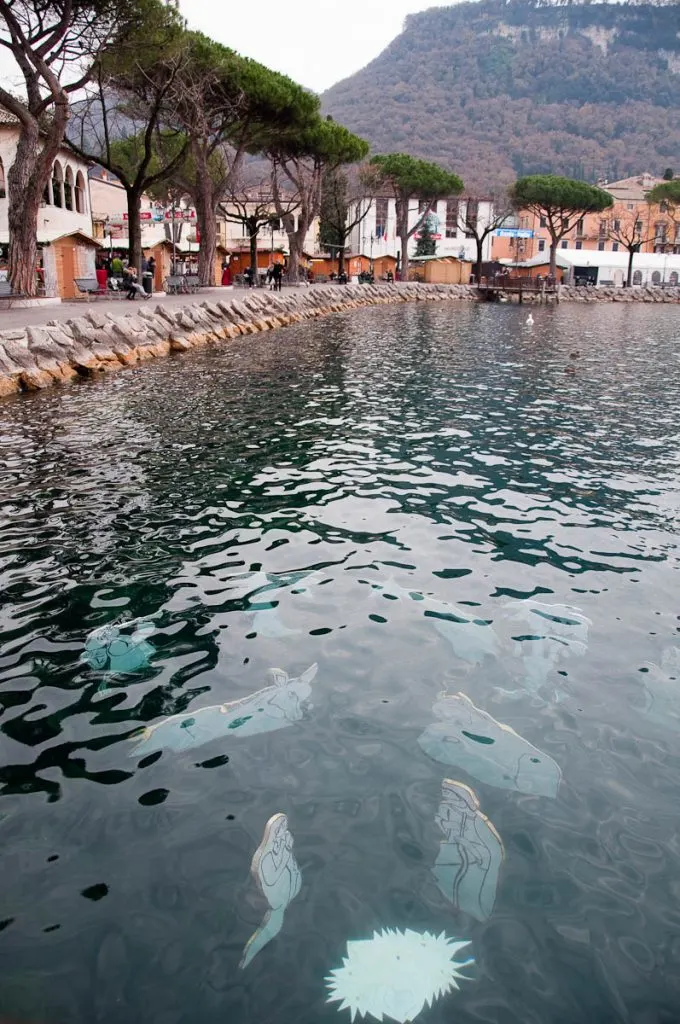
Italian towns that are close to a river, a lake or the sea – often place a large Nativity Scene either on a boat anchored just offshore or simply on the bottom of the body of water. It makes for a curious and rather lovely thing to see during the Christmas season.
I particularly loved seeing the underwater Nativity scenes that some of the towns on Lago di Garda would place every year on the bottom of Italy’s largest lake. The most popular ones were in Garda Town (pictured above) and in Peschiera del Garda.
Also at Lake Garda, I loved seeing the Nativity scene of Cassone. This small village on the eastern shore of the lake has two claims to fame. One is that it was once painted by the famous symbolist artist Gustav Klimt (of ‘The Kiss’ fame). His painting of Cassone was sold a few years ago for almost 27 million British pounds. The other is that in Cassone you can see Italy’s shortest river – Aril. It’s only 175 m long! It’s on Aril that every year the locals place a large and rather creatively designed Nativity scene.
You can see an over-the-water and an underwater Nativity Scene in the Venetian Lagoon, too. The former is placed near Cavallino Treporti and the latter – near the island of Lido. Venice’s underwater Nativity scene is carved into a marble slab that is 50 x 50 cm in size. It is positioned at the exact spot where a Croatian ship sank in 1961 with four members of the crew losing their lives.
Another famous underwater Nativity scene in Italy is placed every year on the bottom of Lago di Cornino. This is a small lake with strikingly turquoise water. You will find it in Italy’s northeasternmost region – Friuli Venezia Giulia. On Christmas Eve, the members of the local diving club dive into the lake and slowly elevate the figures of the Nativity scene above the water in an original recreation of the Nativity Story.
In Grado – a historic seaside town in the same Italian region – you can see a Nativity scene built on top of a large raft. Anchored in the town’s harbour, this presepe comes with the added curiosity that instead of a cave, Baby Jesus’s manger is placed in a cassone – a large fishermen hut typical for the area.
13. There Are Also Living Nativity Scenes in Italy
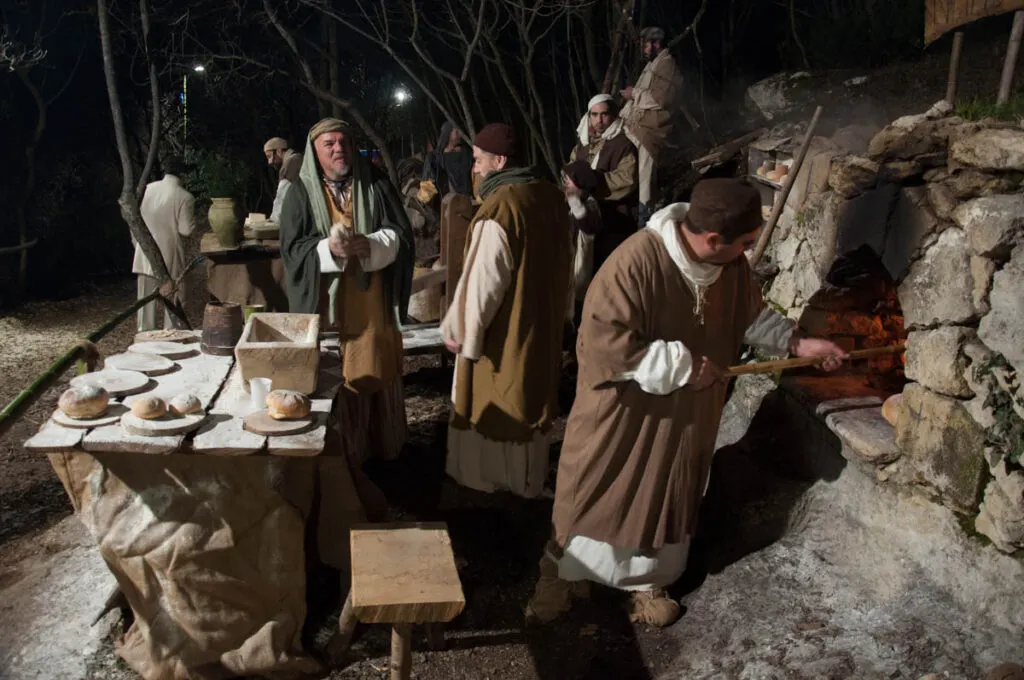
Living Nativity scenes are another major element of Christmas in Italy. Known as presepe vivente in Italian, they are one of the most curious and delightful events to experience during the Italian festive season. Groups of local volunteers stage elaborate representations of the Nativity Story in caves, on town squares or as a procession along a city’s main streets. Cittadella in the Northern Italian region of Veneto, for example, has a living Nativity scene that is held on top of the medieval defensive wall that encircles the historic centre of the town.
Often hundreds of people take part in Italy’s living Nativity scenes and recreate in minute detail the town of Bethlehem on the eve of Christ’s birth. Dressed in full costume, they set up small tableaux vivants showing how people used to live over 2,000 years ago. Anywhere you go in Italy at Christmas, there will be a living Nativity scene taking place before or after Christmas Day. It is definitely one of the highlights of the Christmas calendar in Italy. It is also a wonderful celebration of the miracle of Christmas and a great way to experience Italy’s authentic community spirit.
The world’s first living Nativity scene was held in 1223 in the Italian village of Greccio (nowadays in the Central Italian region of Lazio). It was staged by St. Francis in order to nurture the worship of Christ. According to ‘The Life of St. Francis of Assisi’ by the Franciscan friar St. Bonaventure, St. Francis set up a manger in a cave with a bale of hay and two live animals – an ox and a donkey. Then, overcome by emotion, he preached to the people who had come to see him.
You can read the heartfelt description of the event in the words of St. Bonaventure himself under point 7 of Chapter X of his book here. As described by him, a miracle happened during this first living Nativity scene. A knight – Messer John of Greccio – had a vision of a sleeping child in the manger during the sermon of St. Francis. The local people also saved the used hay and in the months to come utilised it as a miraculous cure for their ill animals.
Nowadays, the world’s largest living Nativity scene takes place outside of the small village of Genga in the Central Italian region of the Marche. Over 300 people of all ages take part in it. There are bakers, blacksmiths, shepherds, washerwomen, merchants, noblemen, and Roman soldiers. Every social stratum of Bethlehem is represented. There is even a small pond where fishermen catch fish and ovens where bakers prepare bread all day long. For added authenticity, there are also many domestic animals like chickens, goats, sheep, and even newborn lambs. The Infant Jesus is a tiny baby huddled in the arms of his doting mother dressed as the Virgin Mary. Surrounded by Joseph, the Three Wise Kings and a cohort of shepherds, they stand in a small cave while thousands of people come to see them.
I loved seeing a living Nativity scene during our Italian Christmases. These three left me with memories of a lifetime:
- Living Nativity in Vicenza – this is a great event to see in the first weeks of December in the small Northern Italian city of Vicenza. A long procession of shepherds and Roman soldiers traverses the historic centre. Mary – in the late stages of her pregnancy and on a donkey – is supported by Joseph. It is a city-wide celebration with hundreds of people coming out to see the procession.
- Presepe Vivente in Grotta di Villaga – this is a large and very elaborate living Nativity scene. It attracts thousands of spectators and takes a great deal of organising with a special queuing system in place. The different episodes of the Christmas Story are staged in a series of natural caves. We spent hours waiting for our turn to walk past the tableux vivants but it was all worth it. Click here to see photos of this living Nativity on my Facebook page.
- Living Nativity in Castelfranco Veneto – this is a lovely event in one of the prettiest small towns in Veneto, Northern Italy. Held next to the town’s massive defensive walls, it is a great experience. Click here to see photos of this living Nativity and the Christmas decorations of Castelfranco Veneto on my Facebook page.
14. The Nativity Story Has Inspired Some of Italy’s Most Important Works of Art
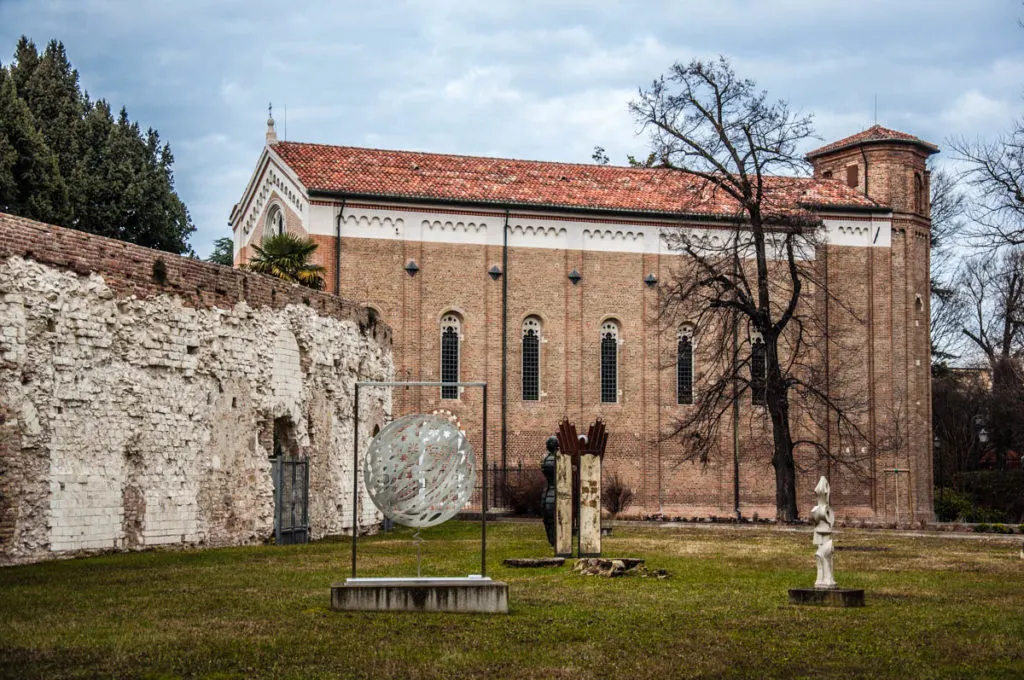
The Nativity Story is beloved in Italy. It is a simple account of a child being born in humble surroundings, under extraordinary circumstances, and with a divine purpose – to become the Saviour of the world. When you think of it, isn’t this the story and the potential of every child being born?!
The Nativity Story appeals to people of all ages and any social status. It is easy to understand. It brings hope. It proves that humble beginnings are not an obstacle to achieving great things.
It’s not surprising then that the Nativity Story has always been a major source of inspiration for Italy’s creative output. Painted on canvas, frescoed on walls, carved from stone, many of the most important works of Italian art depict the events of Christmas Eve and Christmas Day two millennia ago.
Any time that you travel to Italy – be it Christmas, summer, or any other season of the year – you can get close to the spirit of Nativity here and experience the beauty of its message of hope. In small churches and large museums all over Italy, you will come across many beautiful and inspired representations of the Birth of Christ. Painted and carved both by worldwide famous artists and creators whose names have been lost in the passage of time, they will touch something in you.
Here are five of the most impactful and most beautiful interpretations of the different episodes of the Nativity Story that can be seen in Italy. I picked them based on the emotions they inspired in me when I had the chance to see them. I hope that you will love them, too!
- Nativity, Birth of Jesus – painted by Giotto in 1306 in the Scrovegni Chapel in Padua, Northern Italy. Giotto’s frescoes in this small chapel (pictured above) on the edge of Padua’s historic centre are considered to be the first artistic spark of the Italian Renaissance.
- The Magi – a splendid 6th-century mosaic in the Basilica of Sant’Apollinare Nuovo in Ravenna. It depicts the Three Wise Kings offering their gifts. The names of the Magi – Balthassar, Melchior, and Caspar – are spelled at the top edge of the mosaic panel. It is believed that this is the earliest mention of their names in Christian art.
- The Adoration of the Magi – a breathtaking 16th-century canvas by Paolo Veronese in the Church of Santa Corona in Vicenza, Italy. This monumental in its size work of art impresses with its vivid colours and the skillfully organised group of people and animals. The mustard yellow of the cloak of the kneeling King in the front plane is particularly striking.
- The Procession of the Magi – an absolutely splendid fresco by Benozzo Gozzoli in Chapel of the Magi in the Palazzo Medici Riccardi in Florence. Obviously, the Medici and their heirs are depicted centre stage of this lavish cavalcade on the way to Bethlehem. I dare you to stand in front of this display of power set in the context of one of the world’s most famous stories and not to feel in absolute awe!
- Adoration of the Magi – another splendid depiction of the visit of the Three Wise Kings to the newborn Baby Jesus in Bethlehem. Painted by Gentile da Fabriano in 1423, this pinnacle of the International Gothic artistic period nowadays it’s in the Uffizi Gallery in Florence.
In addition, if you find yourself in the Renaissance town of Urbino in the Central Italian region of the Marche, make sure that you visit the Oratory of San Giuseppe. Just a short distance away from the birth house of the famous artist Raphael, this oratory has a large, permanent Nativity scene that was made of stucco back in 1545.
15. Italian Presepi Keep Evolving and Can Be a Platform to Make a Statement
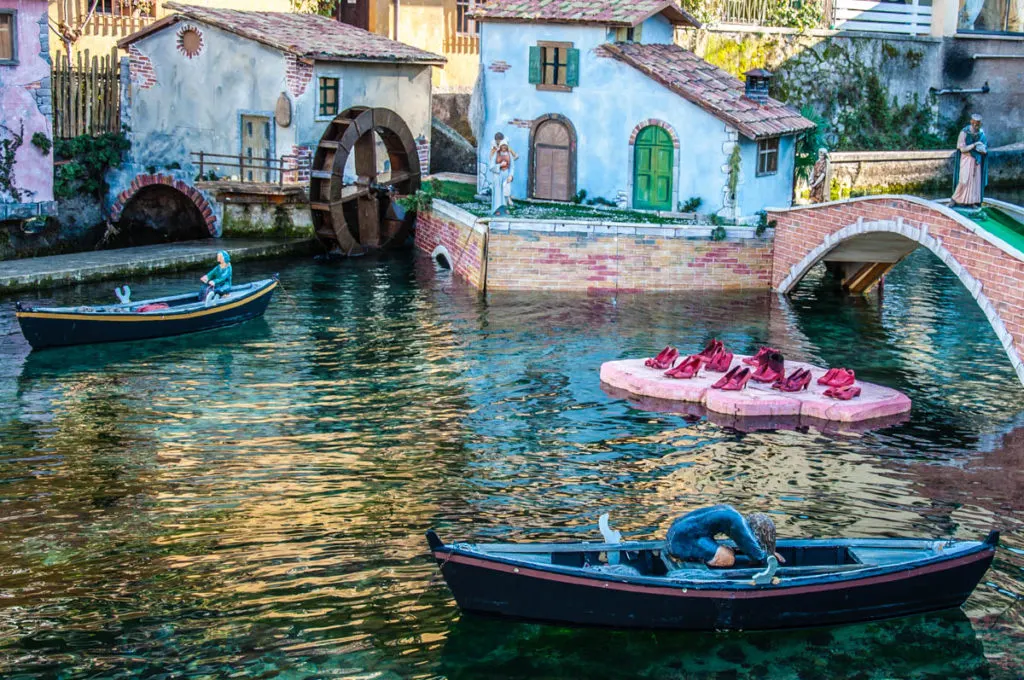
Nothing is set in stone and Italy’s presepi keep evolving year after year. While the traditional Italian Nativity scene still very much tells the Christmas Story, forward-looking craftsmen and designers attempt to bring a new lease of life and inspirations to it every now and then. This is not always well-received, though!
I still remember a beautiful Nativity scene set up in a large shopping centre in Northern Italy. It had a lot of automated elements, light changes, and some energetic pieces of music. While I was enthralled, an older Italian lady standing next to me, puffed with contempt, declared it ‘A disco club in bad taste!’ and stalked out in a huff.
At the same time, a Nativity scene in Italy can be used as a platform to make a statement and take a stance. A few years ago, for example, the Nativity scene erected on the waters of Italy’s shortest river Aril in the village of Cassone was dedicated to the fight against violence against women. Femicide – the murderous violence against women – claims dozens of lives in Italy every year.
Jealousy and a sense of possession are daily problems in many relationships both in Italy and around the world. Hence, among the peaceful Biblical episodes depicted by the Nativity scene on the river Aril, there was also a floating platform with red shoes – the symbol of all women lost to violence. There was also a small boat with the figure of a woman, huddled into a ball and all by herself as a symbol of the feeling of loneliness and isolation from the world one suffers in violent relationships.
In Conclusion

The presepe (also called presepio) is one of the most interesting and central elements of the Christmas celebrations in Italy. Known as a Nativity scene in English, it has a history that spans almost 16 centuries. The presepe is a three-dimensional representation of the Biblical episodes of the Nativity Story. It can be of different sizes – from tiny ones that fit on the palm of your hand to human-size and even larger. It can be made of different materials – from the traditional wood and paper mache to new mediums like resin and even sand.
Come to Italy during the long Christmas season and you will see Nativity scenes everywhere. They take a pride of place in the Italian homes, churches, and public spaces. The rest of the year, you can still see presepi here – in museums, in specialised artisan workshops, and depicted in many precious works of art.
With traditions that have been honed over many hundreds of years, Italy’s Nativity scenes are an integral part of the Italian culture. If you have ever wanted to know more about them, this blog post gives you lots of detailed information about the origins of the presepi and the customs attached to them in modern-day Italy.
The facts I share with you about presepi are based on my first-hand experiences accumulated during the six years that I spent living in Italy and on many hours of in-depth research. I hope that this blog post is of interest and help to you.
Enjoy seeing Italy’s Nativity scenes during your visit to this beautiful country!
And if you happen to be there around Christmas, then I wish you ‘Buon Natale!‘.
More Helpful Info about Christmas in Italy for You
Christmas in Italy: Things to Do, Fun Facts, Christmas Guide, Santa Runs, Christmas Gift Bearers, Christmas Markets
Christmas Food in Italy: Panettone, Mandorlato Veneto
Italian Cities at Christmas: Padua, Vicenza
Christmas Photos and Videos: Christmas Market in Garda Town, Santa Motorcycle Event, Underwater Nativity Scene on Lake Garda, Turning on the Christmas Lights in Vicenza, Christmas Lights in Vicenza, Large Nativity Scene in an Italian Monastery, Christmas Decorations in Cittadella
More Helpful Italy Info for You
Best of Italy: Italian Piazzas, Italian Food, Italian Markets, Italian Coffee Culture, Rules of Italian Breakfast, Italian Breakfast Foods
Northern Italy: 18 Best Cities to Visit, 11 Major Airports
Day Trips in Italy: Bologna to Venice, Venice to Milan, Verona to Milan, Milan to Verona, Venice to Verona, Milan to Venice, Florence to Venice, Verona to Venice, Venice to Padua
Lake Como: Things to See, Nesso
Veneto: Best Cities to Visit, Prettiest Small Towns, Most Beautiful Villages, Top 15 Places, 30 Adventures, 15 Most Colourful Places, Beautiful Lakes
Lombardy: Best Cities and Towns
Friuli Venezia Giulia: Venzone, Most Beautiful Villages
Emilia Romagna: Bologna, Ravenna, Comacchio, Most Beautiful Villages
Marche: 6 Reasons to Visit, Gradara, Frasassi Caves, Temple of Valadier
Trentino: Best Cities and Towns, Beautiful Lakes, Lake Caldonazzo, Violins’ Forest
Venice: Major Landmarks, Essential Tips, Hidden Gems, One Day Itinerary for Art Lovers, Best Airports, Boats in Venice, Haunted Venice, Day Trips from Venice
Verona: Things to Do in One Day, Verona Opera Festival, Day Trips from Verona, Romeo and Juliet Itinerary
Padua: Things to Do in One Day, 101 Facts About Padua, 10 Reasons to Visit Padua, Day Trips from Padua
Vicenza: Things to Do, Day Trips from Vicenza, Best Museums
Thank you for reading! Please, leave me a comment, pin the images below or use the buttons right at the top and at the end of this blog post to share it on social media.
For more useful information like this, please, like my blog’s page on Facebook and subscribe to my strictly no-spam newsletter.
